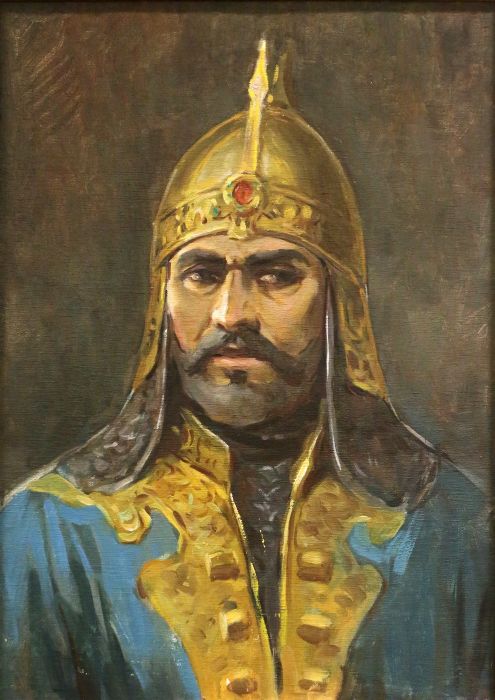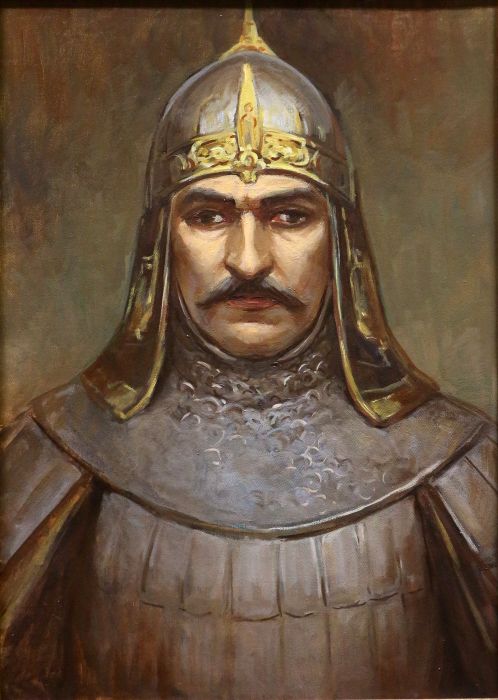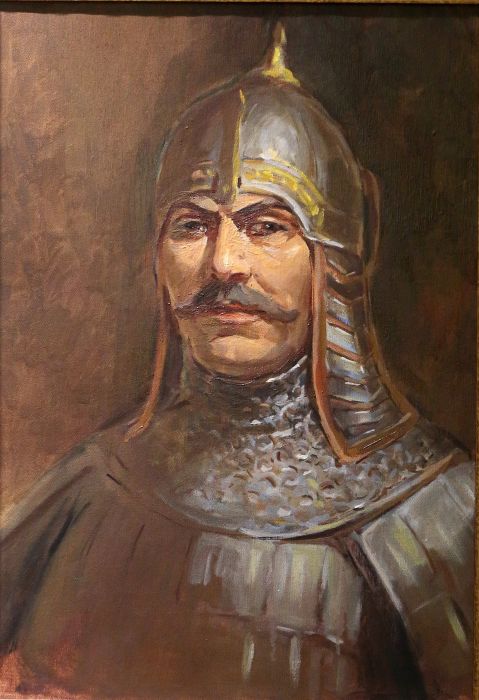Kutalmışoğlu Süleyman Shah - 1077 - 1086
He was the founder of the Anatolian Seljuk State. He participated in the Battle of Malazgirt with Alparslan. The conquest army in Anatolia won the battle against the Byzantine army around Kayseri and proceeded to the Marmara coasts, Izmit without encountering any obstacles. Süleyman Bey conquered Central Anatolia with Konya. In 1075, he captured Iznik, an important Byzantine city, and his public, and settled in Iznik. On the one hand, while the conquests continued, on the other hand, Turks were brought and settled in the conquered lands. Süleyman Shah, who conquered many settlements in Anatolia, attacked Tutus with his army for ending the plan of Sultan Tutus, the brother of Sultan Meliksah, who acted to establish a state in Syria. Two armies came across in Aleppo on 1086. At the most violent stage of the battle, some soldiers left the side of the Suleiman Shah and pass to the other side. Then the army of the Solomon Shah was destroyed. He became a martyr while fighting in battlefield.
Ebu'l-Kasım - 1086 - 1092
He was the ruler Iznik city in the early periods of the state. He has ruled Anatolian Seljuk State for a period of six years in the post-interregnum after the death of Kutalmışoğlu Süleyman Shah, the founder of the dynasty.

I. Kılıç Arslan - 1092 - 1107
In 1092, he owned İznik throne by ending the interregnum continuing in Anatolian Seljuk State. He strengthened the defenses of the city by initiating activities for the constrution of İznik. The attacks against Iznik were eliminated and the Byzantines were allowed to be thrown from Balıkesir and Kapıdağ regions. The Byzantines tried to drive a wedge between the Turkish bey and sailor Çaka Bey and I. Kılıç Arslan, who were the dominant figures of İzmir. During interregnum, he acted for establishing an union by gathering the cities that had left Anatolian Seljuk State under one flag. In 1096, he surrounded Malatya city. While the Malatya Castle was about to fall, the siege was abolished when they learned that the Crusader army had entered Anatolia from the west. Sultan Kılıç Arslan quickly headed towards Western Anatolia and came up against the Crusaders by the army. I. Kılıç Arslan succeeded to capture Mosul in 1107, but he was defeated in the battle near Habur river against Emir Caval, Artukoglu Ilgazi and Syria Meliki Rıdvan and he died by drowning in the river.

I. Melikşah (Şahinşah) - 1107 - 1116
Melikşah was taken prisoner by Emir Çavli in the battle where his father I.Kılıç Arslan was dead and he was taken to Isfahan. Melikshah remained as prisoner until 1110 and during these 3 years there was a great conflict in Anatolia. The Byzantines have begun to regain their lands in western Anatolian. The Anatolian Seljuks were drawn back into Anatolia.
Meliksah was freed in 1110 and was seated to the throne of Anatolian Seljuks in Konya, but he could not prevent the land losses of the Seljuks in Anatolia. Also his brother I. Rükneddin Mesud, did not accept the Sultanate of Meliksah. Danişmends became the strongest Turkish state in Anatolia by taking advantage of the weakness of the Anatolian Seljuks.
I.Rükneddin Mesud - 1116 - 1156
I. Rukneddin Mesud is Anatolian Seljuk Sultan with the longest period. I. Rukneddin Mesud was under the supervision of the Danishmends for a while. After the death of Mehmed Bey from Danishmend in 1142, the Anatolian Seljuks rebuilt the dominance of Anatolia. They defeated Byzantine army in front of Konya in 1146. The following year, he defeated II Crusade army near Eskişehir. I. Mesud divided his country among his three sons according to the tradition. II. Kılıç declared Arslan as the crown prince and died in 1156. After his death, the throne wars began between his sons. His grave is in Amasya Simre town. Western sources are mentioned in Anatolia in the name of Turkey for the first time in history.
II. Kılıç Arslan - 1156 - 1192
II. Kılıç Arslan came from Elbistan where he was a king to Konya and ascended the throne. However, other groups in Anatolia who made benefit of these throne battles, had some alliances against the Anatolian Seljuks. In order to keep the state alive, II. Kılıç Arslan looked for ways to make peace with the Byzantine Empire and went to Istanbul and made a treaty. By securing the Western border, II. Kılıç Arslan headed to Anatolia. He and his brother Şahin Shah defeated the combined army of Danişmends and took Ankara, Darende and Kayseri from Danishmends and ended the domination of the Danishmend in 1175. After a while, the peace between II.Kılıç Arslan and Byzantium broke down. In 1176, he ambushed Byzantine army in Miryakefalon war in the eastern of Sandıklı and Dinar and within the boundaries of Isparta's Gelendost district and Byzantine army had a heavy defeat. This was the greatest victory of the Turks after Malazgirt against Byzantium in Anatolia. II. Kılıç Arslan divided his country among 11 sons in 1186. In 1192, after Kılıç Arslan's death, his son I.Gıyaseddin Keyhüsrev ascended to the throne.
I. Gıyaseddin Keyhüsrev - 1192 - 1196/1205 - 1211
He ascended to throne in two different periods. When II. Kılıç Arslan died in 1192, Gıyaseddin Keyhüsrev ascended to the throne by becoming dominant over his other brothers. However, he had to leave the throne to Süleyman Shah in 1196. When II Süleyman Shah died in 1204, III. Kılıç Arslan who was the son of II.Süleyman Shah ascended to throne. However, within a period of 8 months, Gıyaseddin Keyhüsre, who prevailed on the nephew, ascended to the throne for the second time in 1205. I. Gıyaseddin Keyhüsrev cut trade routes in the Black Sea and launched an expedition against Trabzon Greek Empire and re-opened the road to the Turks. Then he added Antalya, an important foreign trade port, to his lands. I. Gıyaseddin Keyhüsrev strengthened the central government by ending the tradition of the sultans to share the territory of their country among their sons. The princes have become governors of the central government. I. Gıyaseddin Keyhüsrev was defeated and killed in 1211 during a war made against Iznik Emperor Teodor Laskaris.
II. Rükneddin Süleyman Şah - 1196 - 1204
After the death of II.Kılıç Arslan in 1192, his son Gıyaseddin Keyhüsrev ascended to the throne. However in 1196 he had to leave the throne to his brother II. Rukneddin Suleyman Shah. Süleymanshah took Amasya, Niksar and Elbistan under his reign for rebuilding Turkish unity which was shattered in Anatolia. The Byzantine emperor, who benefited from these struggles, took action in the Black Sea coasts. Suleiman Shah prevented these developments and made a treaty with the emperor and then he defeated Cilicia Armenian king of II. Leon and forced them to retreat to the south of the Taurus Mountains. After forcing Byzantine emperor to pay money and punishing Armenian kingdom, he turned to East Anatolia and took Malatya. On the other side, he took Erzincan Mengücükoğulları and Artukoğulları. In 1202, he added Erzurum to his country and ended Saltuklus and became neighbor with Georgians. In the same year, Suleymanshah lost battle against Georgians in Sarikamis and died between Konya and Malatya while he was leaving fro second Georgia expedition after taking Ankara from his brother Mes'ûd.
III. Kılıç Arslan - 1204 - 1205
He ruled for a short period like eight months. Upon the death of his father in 1204, he ascended to throne in Konya as a child. In the meantime, the Fourth Crusade seized Istanbul and established the Latin Empire in Istanbul. His uncle, I. Gıyaseddin Keyhüsrev who was dethroned by his father forced III. Kılıç Arslan to leave the throne with the support of Turkmens. The Danishmend Turkmens took Isparta Castle. In 1205, I. Gıyaseddin Keyhüsrev ascended the throne. He forced III. Kılıç Arslan and his servitors to live in Gevele Castle. III. Kılıç Arslan was killed there.
I. Izzeddin Keykavus - 1211 - 1220
Upon the death of his father I. Gıyaseddin Keyhüsrev, he ascended to throne in 1211. First he has defeated his brother, I. Alaeddin Keykubad who rebelled against him thus himself, thus he gave all his attention to the revival of trade in Anatolia after he had strengthened his government. He concluded an agreement with the Kingdom of Cyprus to liberalize trade between the two countries. He took Sinop from the Greek Empire of Trabzon to open the northern trade route. Then, he walked over the Armenian dervishes that blocked the southern trade route and defeated the Armenians and opened the Syrian trade route. Thus, Anatolia became the center of trade caravans. Izzeddin Keykavus I died in 1220 and his brother Alaeddin Keykubad ascended to throne.

I. Alaeddin Keykubat - 1220 - 1237
He is the most famous Anatolia Seljuk Sultanate of Turkey and the world literature due to the his works and the prestige which he brought to himself and the state in terms of his military and administrative aspect. In 1205, he was appointed as Tokat meliki (governor) and learned of state administration and had experience. His name was given to the city rebuilt and surrounded by strong walls and the city got the name of Alaiye (Alanya). Alaeddin Keykubad built a shipyard and armory in this city and rebuilt the city's castle. Sultan Alaeddin, build a navy in in Sinop to break the power of the Greek Empire of Trabzon. By understanding the danger of Mongol, Alaeddin Keykubad strengthened his eastern borders. During this strengthening, Ahlat was conquered. However, this conquest led to a break with the Ayyubids. He defeated the army sent by the Ayyubis in the south of the Taurus and captured Harput and Urfa. He successfully managed ambassador of Mongol empire before his death, and he saved Anatolia from the Mongolian invasion. He was killed in 1237 in Kayseri by being poisoned during a banquet.
II. Gıyaseddin Keyhüsrev - 1237 - 1246
II. Gıyaseddin Keyhüsrev is the eldest son of I. Alaeddin Keykubad. Although his father appointed his younger brother, Izzeddin Kılıç Arslan, as the crown prince, he ascended to throne of Anatolian Seljuks with the support of some amirs under the leadership of Sadeddin Köpek upon the death of his father. He fought against the Harzem amirs who were the supporters of his brother. In 1240, Diyarbakir was handed over to Anatolian Seljuks. Nomadic Turkmens who escaped from Mongols and took refuge in Anatolia and new problems occurred within the established state structure in Anatolia. Under these circumstances, Babai revolt initiated by Baba ishak was suppressed. However, it shook the power of state in considerable amount. The Mongols who benefited from the weakening of the Anatolian Seljuks, took over Erzurum. The Anatolian Seljuk army was defeated in Kösedağ War. After war II. Keyhüsrev escaped to Western Anatolia. After the peace with the Mongols was provided, the sultan returned to Konya and left the state affairs to his vizier Semseddin Isfahani. In 1243, II. Gıyaseddin Keyhüsrev was defeated by Mogul commander Baycu Noyan in Kösedağ War and went to Antalya and died there in 1246.
II. İzzeddin Keykavus - 1246 - 1260
II. Izzeddin Keykavus ascended to throne instead of his father and within the same year he sent his brother IV Kılıç Arslan as an ambassador to Mongolia to be present at the throne ceremony of Mongol Han Guyak. Mongols was satisfied from IV. Kılıç Arslan and recognized him as Anatolian Seljuk Sultan. IV. Kılıç Arslan came to the throne in 1248 in Sivas. Thus, the throne trials began between II. İzzeddin Keykavus and IV Kılıç Arslan. The third and the youngest brother II. Alaeddin Keykubad also joined this throne trial. However, with the intervention of the notables of Anatolia, the three brothers were persuaded to rule jointly. Thus, triple power period that will last 8 years in the history of Anatolian Seljuk State, began in 1249.
II. İzzeddin Keykavus ruled west of Kızılırmak river. IV. Kılıç Arslan and II. Alaeddin Keykubad ruled in the eastern Kızılırmak. In 1256, Mongol commander Baycu Noyan made another expedition to Anatolia. He defeated the army of II. Izzeddin Keykavus near Aksaray and thus Anatolia was completely under the rule of Mongol. Triple power period continued till the death of II. Alaeddin Keykubad for unknown reasons in 1257. In 1260, II. Izzeddin Keykavus left Konya and escaped to Crimea and died there in 1279. IV. Kılıç Arslan continued to rule alone until 1265.
II. Alaeddin Keykubad - 1249 - 1257
II. Izzeddin Keykavus ascended to throne instead of his father and within the same year he sent his brother IV Kılıç Arslan as an ambassador to Mongolia to be present at the throne ceremony of Mongol Han Guyak. Mongols was satisfied from IV. Kılıç Arslan and recognized him as Anatolian Seljuk Sultan. IV. Kılıç Arslan came to the throne in 1248 in Sivas. Thus, the throne trials began between II. İzzeddin Keykavus and IV Kılıç Arslan. The third and the youngest brother II. Alaeddin Keykubad also joined this throne trial. However, with the intervention of the notables of Anatolia, the three brothers were persuaded to rule jointly. Thus, triple power period that will last 8 years in the history of Anatolian Seljuk State, began in 1249.
II. İzzeddin Keykavus ruled west of Kızılırmak river. IV. Kılıç Arslan and II. Alaeddin Keykubad ruled in the eastern Kızılırmak. In 1256, Mongol commander Baycu Noyan made another expedition to Anatolia. He defeated the army of II. Izzeddin Keykavus near Aksaray and thus Anatolia was completely under the rule of Mongol. Triple power period continued till the death of II. Alaeddin Keykubad for unknown reasons in 1257. In 1260, II. Izzeddin Keykavus left Konya and escaped to Crimea and died there in 1279. IV. Kılıç Arslan continued to rule alone until 1265.
IV. Kılıç Arslan ruled alone between the years 1260-1265. In 1261, he conquered Konya again. He conquered Silifke from Armenians and Sinop was conquered from Greek State of Trabzon by his commander Muinüddin Pervane. IV. Kılıç Arslan was executed unexpectedly by the Mongols during a feast in 1265 and was buried in the Sultans' Tomb in Konya. Instead of him, his young child III. Gıyaseddin Keyhüsrev was declared sultan as the puppet of the Mongols.
IV. Kılıç Arslan - 1248 - 1260 - 1265
II. Izzeddin Keykavus ascended to throne instead of his father and within the same year he sent his brother IV Kılıç Arslan as an ambassador to Mongolia to be present at the throne ceremony of Mongol Han Guyak. Mongols was satisfied from IV. Kılıç Arslan and recognized him as Anatolian Seljuk Sultan. IV. Kılıç Arslan came to the throne in 1248 in Sivas. Thus, the throne trials began between II. İzzeddin Keykavus and IV Kılıç Arslan. The third and the youngest brother II. Alaeddin Keykubad also joined this throne trial. However, with the intervention of the notables of Anatolia, the three brothers were persuaded to rule jointly. Thus, triple power period that will last 8 years in the history of Anatolian Seljuk State, began in 1249.
II. İzzeddin Keykavus ruled west of Kızılırmak river. IV. Kılıç Arslan and II. Alaeddin Keykubad ruled in the eastern Kızılırmak. In 1256, Mongol commander Baycu Noyan made another expedition to Anatolia. He defeated the army of II. Izzeddin Keykavus near Aksaray and thus Anatolia was completely under the rule of Mongol. Triple power period continued till the death of II. Alaeddin Keykubad for unknown reasons in 1257. In 1260, II. Izzeddin Keykavus left Konya and escaped to Crimea and died there in 1279. IV. Kılıç Arslan continued to rule alone until 1265.
IV. Kılıç Arslan ruled alone between the years 1260-1265. In 1261, he conquered Konya again. He conquered Silifke from Armenians and Sinop was conquered from Greek State of Trabzon by his commander Muinüddin Pervane. IV. Kılıç Arslan was executed unexpectedly by the Mongols during a feast in 1265 and was buried in the Sultans' Tomb in Konya. Instead of him, his young child III. Gıyaseddin Keyhüsrev was declared sultan as the puppet of the Mongols.
III. Gıyaseddin Keyhüsrev - 1265 - 1284
When he ascended the throne, Anatolian Seljuk State was completely under Mongol rule. In 1277, the Mamluk sultan Baybars invaded Anatolia and took the Seljuks under his ruling. However, the Mamluks did not stay in Anatolia for a long time, and sovereignty was again handed over to Mongols. III. Gıyaseddin Keyhüsrev was executed by the Mongols in 1282. II. Gıyaseddin Mesud who is the son of his uncle, ascended to the throne of Anatolian Seljuks which was extremely weak.
III. Alaeddin Keykubad - 1293 - 1294/1301 - 1303
He is the grandson of II. Izzeddin Keykavus. After the Kösedağ War, the Anatolian Seljuk State entered the dominance of the Mongols. The Mongols kept the Seljuk Sultans under strict control. In the period of Alaeddin Keykubad, there were some conflicts in Anatolia, and the Mongols forced him to leave the throne and they replaced him with II. Gıyaseddin Mesud. After III. Alaeddin Keykubad left the throne, he was sent to Tabriz sentenced to death. However, his wife was from Mongol dynasty and thus he was forgiven. III. Alaeddin Keykubad was stabbed and killed by one of his servitors for saying high words. When III. Alaeddin Keykubad was on the throne, Osman Gazi was given the title of seigniory for his previous conquests. The year 1299 when Osman Gazi was given the title of seigniory, was accepted as the foundation date of the Ottoman State.
II. Gıyaseddin Mesud - 1284 - 1293/1294 - 1301/1303 - 1307
II. Gıyaseddin Mesud II. Izzeddin was the son of Keykavus. He ascended to throne four times in this period when Anatolian Seljuk Empire was ruled under the sovereignty of the Mongols and everytime he was replaced with the son of his brother III. Alaeddin Keykubad. In 1308, Anatolian Seljuk was demolished after the death the last sultan II Mesud.
No comments:
Post a Comment